Read Our
Winery Blog
Making wine is like making art...
With harvest now picking up speed, wine is being made all around. The art of making wine however can be as simple or as complex as the artist chooses. ANYONE can make wine with only the most basic know how. However making "Great Wine" is a magical alignment where nature, science and art converge. Making great wine on a regular basis is not just a skill, it is an Olympic Gold medal level of accomplishment. Most noteworthy winemakers will categorically state that the way to make great wine is to start with the best grapes, scientifically map out your process and stay out of the way as much as possible. You can make bad wine out of the best grapes.... but you cannot make great wine out of inferior grapes!
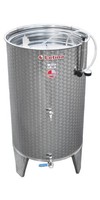
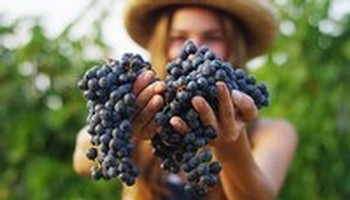 At its simplest, most basic level, making wine is very simple. 1. Harvest your grapes at optimal ripeness 2. Place them in an air cap tank. 3. Add some dry ice and let wine making commence, (Historically, in the country of Georgia Kvevri Jars were filled with grapes and buried underground for winemaking). Ah, but if only it were all so simple. Using the preceding description wine will be made, but unless the process is somewhat controlled it is pure chance whether the wine will be enjoyable or not.
At its simplest, most basic level, making wine is very simple. 1. Harvest your grapes at optimal ripeness 2. Place them in an air cap tank. 3. Add some dry ice and let wine making commence, (Historically, in the country of Georgia Kvevri Jars were filled with grapes and buried underground for winemaking). Ah, but if only it were all so simple. Using the preceding description wine will be made, but unless the process is somewhat controlled it is pure chance whether the wine will be enjoyable or not.
Cleanliness and sterilization are very important as any contamination can quite easily spoil the wine. That being said, most common chemical cleaners are not in play here as they taint the process so you must be very careful to strictly adhere to proper procedure. Once you have your equipment in order, it becomes time to choose the ingredients. Wine can be made from any fruit or vegetable product that contains sugar. I have tasted tomato wine, and carrot wine, and rhubarb wine, and elderberry wine, and strawberry wine, and cranberry wine, and rose petal wine, and pomegranate wine..... but "Vitis Vinifera", the noblest of the grapes are the premium ingredients for making fine wine, and this is generally where the magic happens.
So, what kind of wine do you want to make? White wine? Red Wine? Rosé wine?
 To keep this simple, we will define two sides, red grapes (and the many shades from black to bright crimson) and white grapes (green to pale yellow). In most cases, the pulp of the grape is gong to be pale in color, and in wine the color of the
To keep this simple, we will define two sides, red grapes (and the many shades from black to bright crimson) and white grapes (green to pale yellow). In most cases, the pulp of the grape is gong to be pale in color, and in wine the color of the 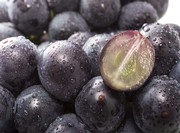 skin can dictate the color of the wine. In white wine, the grapes are harvested cool, destemmed, pressed, and the juice immediately separated from the skins. The pressed juice is then moved to a fresh tank, inoculated with specifically selected yeast (sometimes native yeasts that come in with the grapes are allowed to control fermentation for certain situations) for temperature controlled primary fermentation to begin. Primary fermentation for wines generally takes three to five days.
skin can dictate the color of the wine. In white wine, the grapes are harvested cool, destemmed, pressed, and the juice immediately separated from the skins. The pressed juice is then moved to a fresh tank, inoculated with specifically selected yeast (sometimes native yeasts that come in with the grapes are allowed to control fermentation for certain situations) for temperature controlled primary fermentation to begin. Primary fermentation for wines generally takes three to five days.
The primary fermentation is where the alcohol is generated. At its simplest, the yeast eats the sugar and the result is the creation of alcohol and carbon dioxide. The fermentation process will also generate some heat, so temperature control is important to control the fermentation process accurately. The extent of the fermentation process will depend on the wine and the grapes. The amount of sugar in the grapes (measured in brix) will determine the alcohol level of the wine. The brix levels in the grapes start to rise dramatically in August, and the longer the grapes are on the vine the higher the 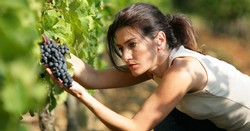 sugar. Bright sunshine and heat will cause the vines to photosynthesize and ripen the fruit more quickly, so ideally July & August will be temperate, cool mornings warm days with gentle sunshine and cool evenings. Extended time on the vine without sugars rising too fast is where the best flavor development happens. Ideally, the warm temperate conditions repeat allowing the winemaker to track the sugar levels along with flavor development and then harvest at their leisure. Extreme heat spikes with no cooling can force an earlier harvest which needs expertise to master and still generate magic.
sugar. Bright sunshine and heat will cause the vines to photosynthesize and ripen the fruit more quickly, so ideally July & August will be temperate, cool mornings warm days with gentle sunshine and cool evenings. Extended time on the vine without sugars rising too fast is where the best flavor development happens. Ideally, the warm temperate conditions repeat allowing the winemaker to track the sugar levels along with flavor development and then harvest at their leisure. Extreme heat spikes with no cooling can force an earlier harvest which needs expertise to master and still generate magic.
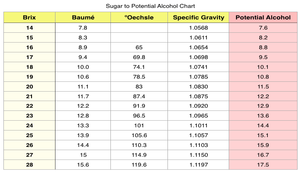
The chart shows the potential alcohol determined by the brix at harvest. If not all the sugars in the grapes get fermented out, the residual sugar level will determine the "sweetness" of the wine. Anything below 0.1% residual sugar is considered dry, and many wines up to 0.2% residual will often present as dry.
Once primary fermentation is complete (about 70% done) the wine will be moved to a second container for fermentation to complete. For some wines, malolactic fermentation is then induced. Unlike primary fermentation, no alcohol is produced in the process. Instead, malic acid (this acid is where the tart, citrus like flavors reside and which make a wine bright and crisp), is converted to lactic acid (often identified as a textural acid that brings a softer richer tone to wines that may be referred to as "buttery" in Chardonnays). This textural exchange impacts the mouth feel and body of the wine. Some white wines are chosen to go through malolactic fermentation, and almost all red wines undergo this step.
 Some of the more common white grape varieties are Chardonnay, Sauvignon Blanc, Gewurtztraminer, Riesling, Viognier, Verdelho, Marsanne, Rousanne, Semillon, Muscat, Albarino, Chenin Blanc, Pinot Gris and so many more. The grape colors range from vibrant green, to opaque yellow, to deep pink but all the wines are white. "Click here" for some basic profiles.
Some of the more common white grape varieties are Chardonnay, Sauvignon Blanc, Gewurtztraminer, Riesling, Viognier, Verdelho, Marsanne, Rousanne, Semillon, Muscat, Albarino, Chenin Blanc, Pinot Gris and so many more. The grape colors range from vibrant green, to opaque yellow, to deep pink but all the wines are white. "Click here" for some basic profiles.
For Rosé wines, the process is very much like making white wine. Rosé is not a specific grape "click here to learn more", but a white wine style using red grapes and limiting the skin contact time to add the appropriate level of pink hue. For Rosé wines, the red grapes are harvested cool and destemmed. Then the juice, skin and seeds are moved to a tank where, depending on the grape variety and style of wine to be made, they will cold soak for 6 to 12 hours before being pressed. The pressed juice is then moved to a fresh tank, inoculated with specifically selected yeast (sometimes native yeasts that come in with the grapes are allowed to control fermentation for certain situations) for temperature controlled primary fermentation to begin.
More and more you will discover "Varietal Rosé", Rosé of Pinot Noir, Rosé of Malbec, Rosé of Cabernet Franc, Rosé of Zinfandel, Rosé of Sangiovese and many more. There are many unique characteristics to be discovered in this genre.
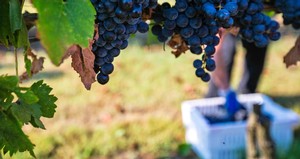 Then there is red wine in its many many visions of glory. Cabernet Sauvignon, Pinot Noir, Malbec, Merlot, Cabernet Franc, Zinfandel, Sangiovese, Carignane, Grenache, Cinsault, Syrah, Petite Sirah, Nebbiolo, Barbera, Barbaresco, Tempranillo, Alicante Bouschet..... the list goes on and on. For red wines, the grapes are harvested cool and destemmed. Then the juice, skin and seeds are moved to a tank where cold maceration takes place. At this point the wine is ready to start fermenting, so to prevent this the contents are kept cold allowing for slow and prolonged flavor extraction. Cold maceration can be as little as 5 hours, and up to 10 days depending on the wine. During this process, the grape skins and seeds will float to the top of the tank, and the juice will sink to the bottom.
Then there is red wine in its many many visions of glory. Cabernet Sauvignon, Pinot Noir, Malbec, Merlot, Cabernet Franc, Zinfandel, Sangiovese, Carignane, Grenache, Cinsault, Syrah, Petite Sirah, Nebbiolo, Barbera, Barbaresco, Tempranillo, Alicante Bouschet..... the list goes on and on. For red wines, the grapes are harvested cool and destemmed. Then the juice, skin and seeds are moved to a tank where cold maceration takes place. At this point the wine is ready to start fermenting, so to prevent this the contents are kept cold allowing for slow and prolonged flavor extraction. Cold maceration can be as little as 5 hours, and up to 10 days depending on the wine. During this process, the grape skins and seeds will float to the top of the tank, and the juice will sink to the bottom.
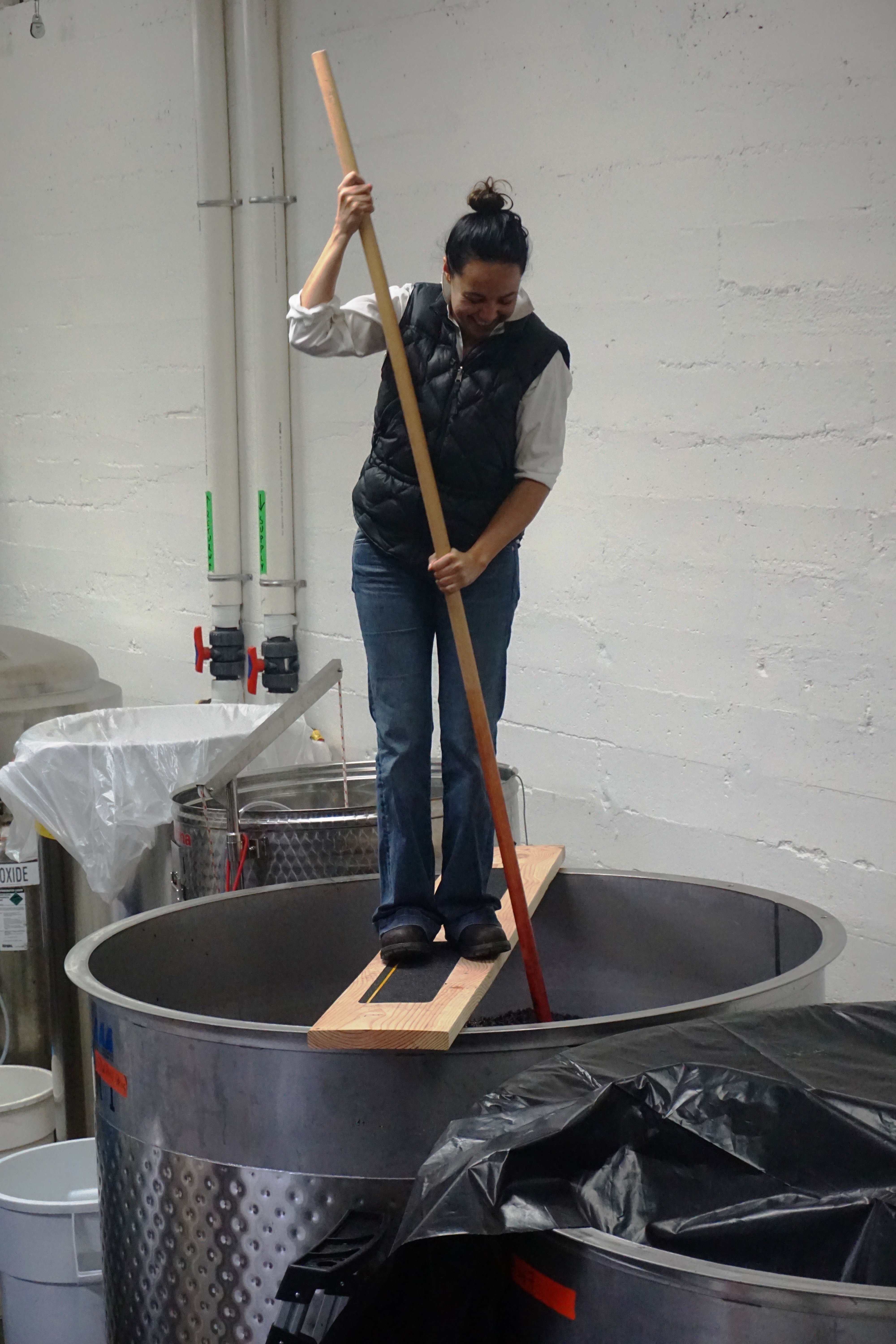 To continue optimal extraction, a "punch down" process or "pump over" will be scheduled throughout the process. The goal here is to extract the precise amount of color, flavor and texture from the solids. In the punch down, the skins and seeds are manually forced back into the juice and in soaking them more of the flavors get extracted.
To continue optimal extraction, a "punch down" process or "pump over" will be scheduled throughout the process. The goal here is to extract the precise amount of color, flavor and texture from the solids. In the punch down, the skins and seeds are manually forced back into the juice and in soaking them more of the flavors get extracted.
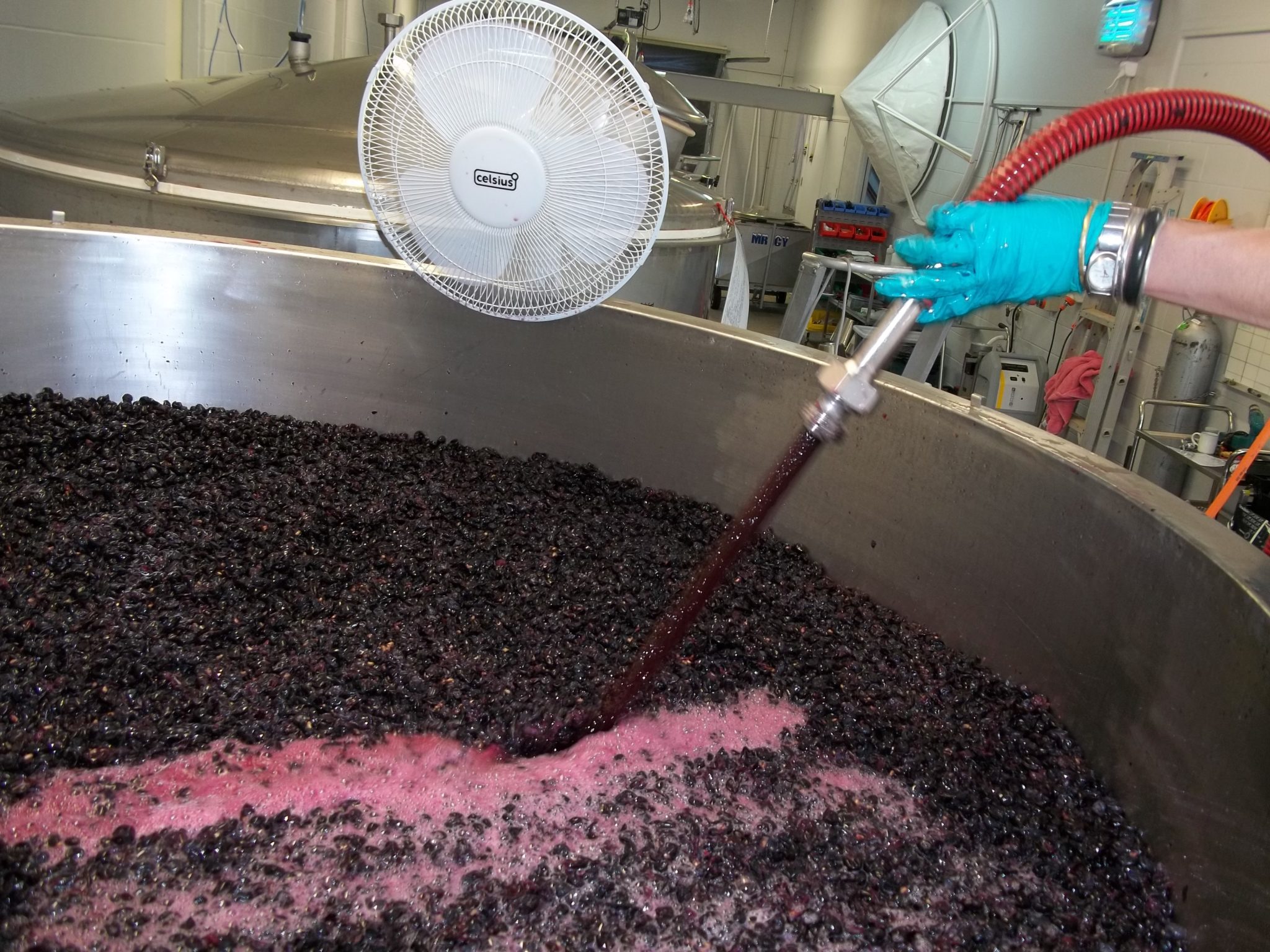 On a larger scale, for the "pump over" imagine the wine tank as a massive coffee percolator. The skins and the seeds float to the top of the tank and the juice sinks to the bottom. We attach a hose to an opening on the bottom of the tank, the tank is connected to a pump, which has a hose on the other end that goes back into the top of the tank. when the motor starts running, the juice is pulled from the bottom of the tank, and pumped over the solids on the top soaking them and extracting more flavor.
On a larger scale, for the "pump over" imagine the wine tank as a massive coffee percolator. The skins and the seeds float to the top of the tank and the juice sinks to the bottom. We attach a hose to an opening on the bottom of the tank, the tank is connected to a pump, which has a hose on the other end that goes back into the top of the tank. when the motor starts running, the juice is pulled from the bottom of the tank, and pumped over the solids on the top soaking them and extracting more flavor.
Once it is determined that the cold soak has drawn out flavors to perfection, the temperature of the juice will be allowed to rise slowly, and the primary fermentation of the red wine will commence whether it be naturally or by inoculation with customized yeasts for specific flavor profiles. This primary and subsequent malolactic fermentation will continue generally from 14 to 24 days depending on the wine, and only once the balance is right will the juices be pressed away (or sometimes just free run) from the skins and the seeds and moved to sterile containers to continue to completion.
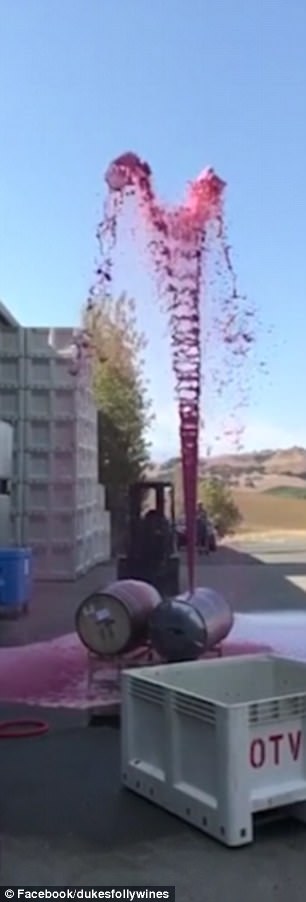 Most typically, red wines will be stored in barrels where fermentation will complete and maturation will commence. Sometimes barrel fermentation can be quite vigorous and it is not uncommon to have barrels blast out the closure and spray foam into the air like a purple geyser.
Most typically, red wines will be stored in barrels where fermentation will complete and maturation will commence. Sometimes barrel fermentation can be quite vigorous and it is not uncommon to have barrels blast out the closure and spray foam into the air like a purple geyser.
Barrel aging can vary considerably, with some wines briefly lingering for 4-5 months, whereas some of the more serious red wines will occasionally age for 4 years in the barrel. Throughout the entire aging process, the wines must be managed, monitored and maintained in good health to avoid any problems. Wines are regularly removed from their barrels temporarily so that the barrels can be "sterilized" with steam before the wine is returned to continue aging.

Once the wine is considered "complete", it is time to bottle. There are various stabilizing processes that need to occur so that the wine entering the bottle is stable and no longer volatile in any way. Some wines may be filtered, some wines not depending on the maker. The bottle is the stable resting place where the wine will remain until it is intended to be consumed......... but that is a whole other story.
So, the basics of making wine. Really simple, and quite complex.
